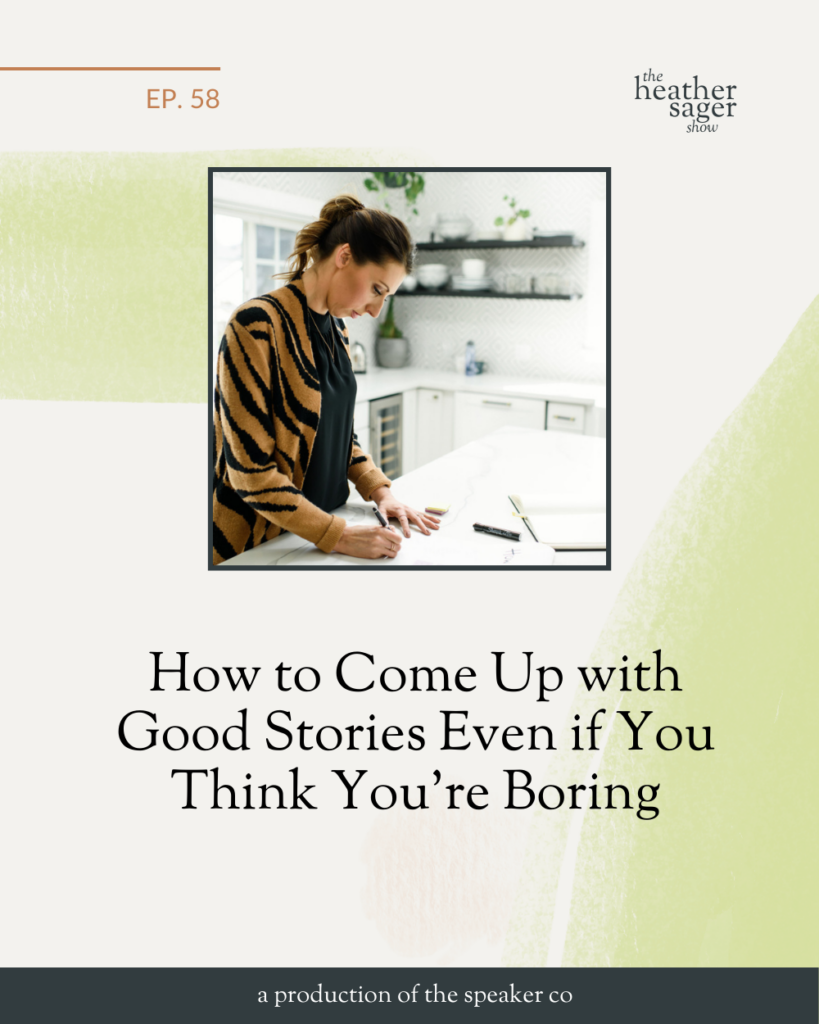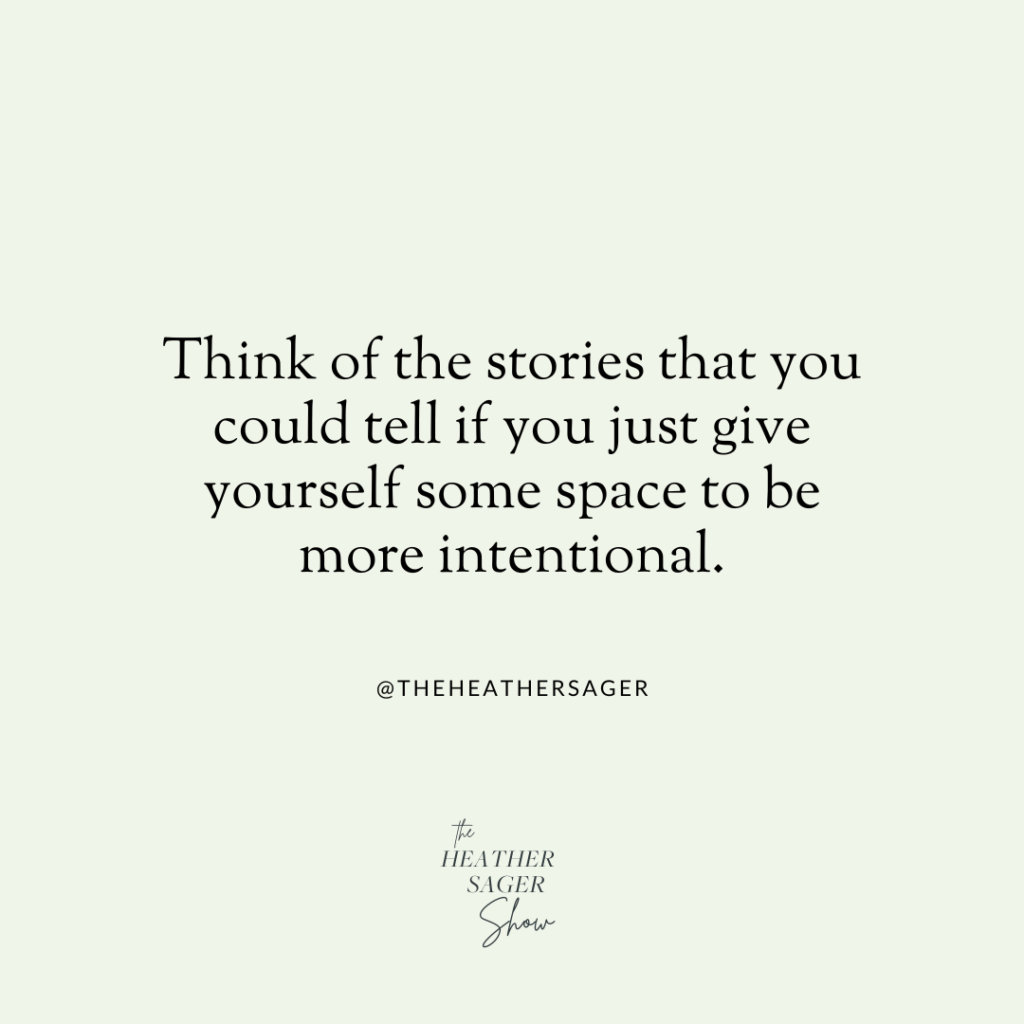
APPLE PODCASTS | SPOTIFY | STITCHER
They say: facts tell, stories sell. I don’t know exactly who “they” are– but they’re right. Stories rock when it comes to captivating and entertaining an audience…
BUT what if you don’t have any good stories? What if you think your life is actually pretty boring (or at least not very interesting to others)?
Or maybe you *know* you have good stories, but whenever you sit down to write an email or prepare for a presentation and try to think of a gem or a tale to illustrate your point, your mind goes BLANK.
Crafting compelling stories is one of the biggest challenges content creators face when it comes to developing their content– AND stories are really the only thing that makes your point of view UNIQUE.
So what you need is a STORY BANK. And today I’m going to teach you EXACTLY how to make one so that your storytelling well never runs dry again.
Inside this episode you’ll learn:
- what exactly makes a “good” story
- how to put to bed the lie: my stories aren’t interesting
- my 3 step process for documenting and organizing stories so you’re never caught trying to think of one on the fly, or skipping a tale all together.
- how to make finding and crafting stories FUN, not stressful
Episode Show Notes:
MYTH: Your life is boring and you have no stories.
(04:46) How we see the world is based around our own beliefs. If you tell yourself you have no stories, you’re going to make that truth.
The reality is our whole life is a story. Every memory we have from our childhood, from our work experiences, waiting in line at the coffee shop, there’s a story everywhere. The difference is whether or not you choose to see your life and what happens around you and with you whether or not you see that as a story.
Rule of thumb between sharing from ‘in the moment’ or ‘after’
(08:54) You have to figure out if you’re from a point where you have resolved in your story, where you feel good about the direction you’re going, where you’re not still in this level of uncertainty where you’re going to bring baggage to other people. That’s when you would not want to be sharing stories or giving advice, when you’re not even clear around the direction you’re taking or what your lessons are yet.
Dual Systems of your Brain and its relation when teaching your content
In his book, Thinking, Fast and Slow by Danie Kanehman, he shares that our brains work on two systems (summarized below):
- System 1 operates automatically and quickly, with little or no effort like ‘click-recall’
- System 2 allocates attention to the effortful mental activities that demand it, including complex computations.
What this means for you: Facts and processes speak to system 2. Don’t overload and overwhelm your audience. When it comes to teaching your content, sharing your frameworks and talking to people about how your niche works, make it easier on your audience to listen by starting with stories.
Stories and analogies are the two best ways to invoke system 1.

3 Steps to Help You Come Up with Story Ideas to Better Connect with Your Audience
1. Get organized with ONE place
(15:55) You need to create a place to store your stories. I call mine: My Story Vault. It should be something that you can access on your desktop AND your cell phone because I want this to be something that you can access no matter where you are.
(18:13) You want to choose a place that you can access it when you remember them (stories). Highly recommend google doc, Evernote, a Trello board, whatever you use. You don’t need to come up with something new, just choose an existing tool you already use (personally, I use google docs).
2. Log stories as they come
BE READY. As soon as the thought enters your mind, think, Hmmm, this might be a story to tell. Get out your vault, write that down as life happens naturally. Don’t try to figure out how or when you’d use it or even what the point is, just write the damn prompt down.
(19:19) There are really good memories from your childhood and earlier in your life that you’ve probably forgot about until someone prompts you to remember. This is where the magic happens. The great part is these conversations of these provoking memories will surface at any point in time. You have to be ready to go when you hear that and be like, ‘Oh damn, that was a good story.’
3. Activate your archive
(21:15) You need to give yourself some space to remember and come up with the stories from years past. I’ll give you a few prompts below to help with this.
Most often, the best stories are the ones that seem seemingly uneventful. It’s the stories of every day. It’s the stories like that that are more connected with other people, so don’t undersell yourself.
Prompts to help you fill your Story Vault
(I recommend you focus on 3-5 year increments in your past).
- In the last three to five years, think back to what are the major things that have happened?
- Where are some places that you’ve had some shifts or transitions? What big adventures have you had?
- What are some moments that made you peed your pants laughing?
- What were some of the most embarrassing moments that you had?
- What are the stories and moments you think of most often? What are the stories that you spill out after you’ve had three margaritas?
- Think about 10 years ago, what were you doing? What was going on in your life in that year?
OK, but how do you connect your story to your content?
(29:43) You can connect pretty much any story to anything. You just need one point to connect one story to another. You just have to start getting creative around, what are the stories that you could tell? What are the stories that you’ve experienced that might resonate, connect, entertain, inform your audience? I highly recommend listening to these 2 episodes dedicated to storytelling to help with this.
- The Power of Story – Virtual Summit Interview – Ep #41
- 5 Essential Truths for Crafting Your Signature Story – Ep#42
And when you start noticing the stories that other people are telling, and start noticing the stories that are happening in your life, you’ll feel like this unlock has happened within your mind, and you will start seeing them everywhere.
Previous Episodes Mentioned:
The Power of Story – Virtual Summit Interview – Ep #41
5 Essential Truths for Crafting Your Signature Story – Ep#42
Books Mentioned:
Stories that Stick, Kindra Hall
Thinking, Fast and Slow, Daniel Kahneman